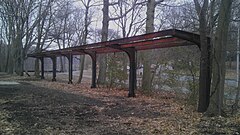Van Cortlandt Park
The last remaining freshwater marsh in New York State, Tibbetts Brook, was dredged and landscaped to accommodate construction, causing large-scale ecological disruption within the park.
[3] The strip of land on the Hudson River's east bank, between the current-day Spuyten Duyvil Creek and Yonkers, was sold to the Dutch West India Company in the early 17th century.
[5] That year the Munsee bands that lived in the lower Hudson River valley briefly occupied New Amsterdam and attacked Pavonia and Staten Island during what is known as the Peach War.
[41][42] Thus, in 1837, construction started on the Aqueduct, which ran 41 miles (66 km) from the Croton River upstate to the New York Public Library Main Branch and Bryant Park in midtown Manhattan.
Olmsted noted the natural beauty of the Van Cortlandt estate, comparing it to Central Park which he designed, and recommended the city purchase the property.
Ultimately, the parks were established despite the objections of major figures like Mayors William Russell Grace and Abram Hewitt; Comptroller Edward V. Loew; and Assemblymen Henry Bergh and Theodore Roosevelt.
[80] In 1907, due to overcrowding, Dr. William Hornaday transferred 15 of the Bronx Zoo's then-rare bison to the Parade Ground,[81] where they stayed until they were shipped to prairie land in Oklahoma later that year.
[113] In 1922, there was a proposal to acquire land for the future Saw Mill River Parkway, which would connect the park to 424 acres (172 ha) of open space in Westchester when completed.
[116] His job partially entailed balancing the needs of area residents, whose numbers had grown in the past decade, with transit users who traveled to the park from the north and south.
The report noted that pollutants from the Major Deegan Expressway were entering Van Cortlandt Lake, and that the park ecosystem was also being harmed by inadequate drainage, soil sterilants that were used on the Putnam Branch tracks, and a fungicide with 8.5% cadmium content that was being sprayed on the golf course.
[146] The city of Yonkers eventually attributed the cause of the Van Cortlandt Lake's pollution to four storm sewers that were found to be illegally connected to Tibbetts Brook upstream.
For instance, the Los Angeles Times noted that "a player was allowed to drop his ball a club length away if it rolled up against an abandoned auto, or, in one case, a boat.
Homeless squatters moved into the park, while courses fell into disrepair, replaced by dirt tracks and "huts and forts" built by neighborhood kids.
[164] Gradual improvements began taking place in the late 1980s, including the addition of new pathways, signage, and security, as well as the restoration of playgrounds and other recreational facilities.
The plant was needed in order to filter contaminants from urban runoff pollution in the Croton River watershed and protect the public from Giardia and Cryptosporidium, microorganisms which can cause serious health problems.
[174] The project experienced delays and ballooning costs due to objections from the local community, which required the city to propose alternate sites for the plant.
The east side of the park near Indian Field contains Yonkers granite, an igneous rock that mixed with Fordham gneiss as a hot magma before later cooling.
[192] The lake is used for recreational fishing,[193] as it includes species such as largemouth bass, black crappie, brown bullhead, bluegill, pumpkinseed, golden shiner, common carp, white sucker, and yellow perch.
[192][194] It is fed by Tibbetts Brook, a stream originating in Yonkers, which runs through a series of culverts before draining into the south edge of the lake at approximately West 242nd Street.
[93][200] A 1903 annual report from the New York City Department of Parks and Recreation mentioned that the lake had probably not been cleaned since the mid-18th century, and now contained a layer of "refuse and vegetation on top, and an ooze two to three feet deep on the bottom," with qualities more like a "semi-bog.
[212] There are several old-growth forests with tree species and genera such as black oak, hickory, beech, cherry birch, sweetgum, red maple, and tuliptree.
[2][213] In 1937, it was noted that the marshlands had fauna such as red-winged blackbirds, yellowthroats, green bottle flies, beetles, dragonflies, tadpoles, herons, kingfishers, and ospreys.
[219] Previously unpaved, the Putnam Trail underwent a reconstruction project starting in August 2019 and was reopened in October 2020 as a paved pedestrian and bicycle path.
[260][261] The Van Cortlandt Stadium was built by Parks Commissioner Moses and Mayor Fiorello H. La Guardia during the Great Depression, and was funded by Works Progress Administration.
[292] On December 11, 1909, the Hamilton Tigers and the Ottawa Rough Riders (later of the Canadian Football League), played an exhibition game at Van Cortlandt Park.
Van Cortlandt Park Conservancy, a private nonprofit organization founded in 2009, managed educational and cultural programs, and maintains the recreational areas.
[309] A year later in 1907, NYC Parks wanted permission to build a road from the Yonkers shuttle's Caryl Station to Broadway in order to alleviate traffic there.
[310] The New York City Board of Estimate received a proposal to connect Manhattan's Riverside Drive to the park in 1909, providing a direct route to the Upper West Side along what is now the Henry Hudson Parkway.
[203] In 1929, Bronx Borough President Harry Bruckner put forth plans for the Grand Concourse to be extended through the park as part of a proposed parkway system.
[365] In Sol Yurick's 1965 novel The Warriors, the meeting between New York street gangs called by Ismael Rivera, leader of the Delancey Thrones, takes place in Van Cortlandt Park.














